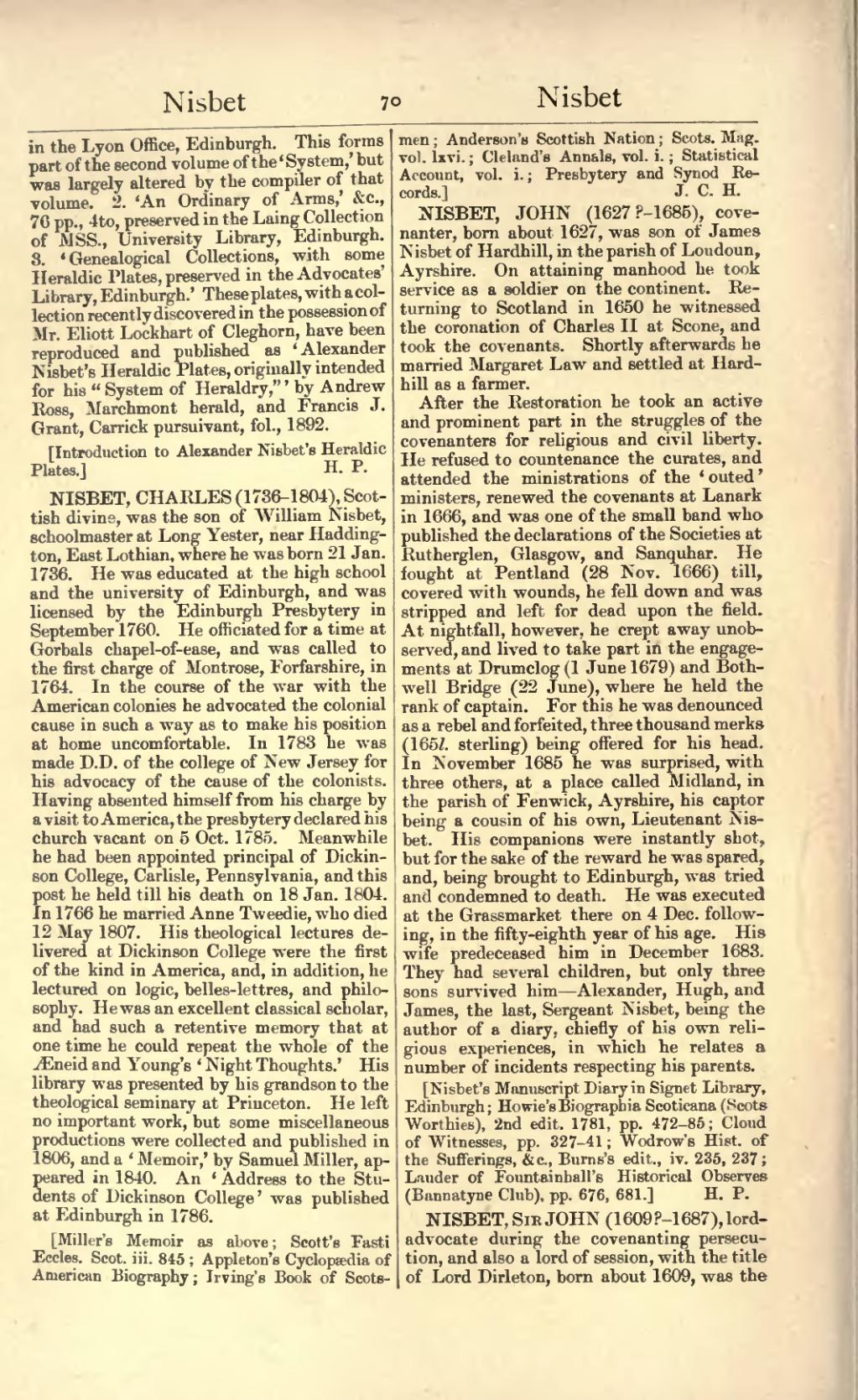in the Lyon Office, Edinburgh. This forms part of the second volume of the ‘System,’ but was largely altered by the compiler of that volume. 2. ‘An Ordinary of Arms,’ &c., 76 pp., 4to, preserved in the Laing Collection of MSS., University Library, Edinburgh. 3. ‘Genealogical Collections, with some Heraldic Plates, preserved in the Advocates' Library, Edinburgh.’ These plates, with a collection recently discovered in the possession of Mr. Eliott Lockhart of Cleghorn, have been reproduced and published as ‘Alexander Nisbet's Heraldic Plates, originally intended for his “System of Heraldry,”’ by Andrew Ross, Marchmont herald, and Francis J. Grant, Carrick pursuivant, fol., 1892.
[Introduction to Alexander Nisbet's Heraldic Plates.]
NISBET, CHARLES (1736–1804), Scottish divine, was the son of William Nisbet, schoolmaster at Long Yester, near Haddington, East Lothian, where he was born 21 Jan. 1736. He was educated at the high school and the university of Edinburgh, and was licensed by the Edinburgh Presbytery in September 1760. He officiated for a time at Gorbals chapel-of-ease, and was called to the first charge of Montrose, Forfarshire, in 1764. In the course of the war with the American colonies he advocated the colonial cause in such a way as to make his position at home uncomfortable. In 1783 he was made D.D. of the college of New Jersey for his advocacy of the cause of the colonists. Having absented himself from his charge by a visit to America, the presbytery declared his church vacant on 5 Oct. 1785. Meanwhile he had been appointed principal of Dickinson College, Carlisle, Pennsylvania, and this post he held till his death on 18 Jan. 1804. In 1766 he married Anne Tweedie, who died 12 May 1807. His theological lectures delivered at Dickinson College were the first of the kind in America, and, in addition, he lectured on logic, belles-lettres, and philosophy. He was an excellent classical scholar, and had such a retentive memory that at one time he could repeat the whole of the Æneid and Young's ‘Night Thoughts.’ His library was presented by his grandson to the theological seminary at Princeton. He left no important work, but some miscellaneous productions were collected and published in 1806, and a ‘Memoir,’ by Samuel Miller, appeared in 1840. An ‘Address to the Students of Dickinson College’ was published at Edinburgh in 1786.
[Miller's Memoir as above; Scott's Fasti Eccles. Scot. iii. 845; Appleton's Cyclopædia of American Biography; Irving's Book of Scotsmen; Anderson's Scottish Nation; Scots. Mag. vol. lxvi.; Cleland's Annals, vol. i.; Statistical Account, vol. i.; Presbytery and Synod Records.]
NISBET, JOHN (1627?–1685), covenanter, born about 1627, was son of James Nisbet of Hardhill, in the parish of Loudoun, Ayrshire. On attaining manhood he took service as a soldier on the continent. Returning to Scotland in 1650 he witnessed the coronation of Charles II at Scone, and took the covenants. Shortly afterwards he married Margaret Law and settled at Hardhill as a farmer.
After the Restoration he took an active and prominent part in the struggles of the covenanters for religious and civil liberty. He refused to countenance the curates, and attended the ministrations of the ‘outed’ ministers, renewed the covenants at Lanark in 1666, and was one of the small band who published the declarations of the Societies at Rutherglen, Glasgow, and Sanquhar. He fought at Pentland (28 Nov. 1666) till, covered with wounds, he fell down and was stripped and left for dead upon the field. At nightfall, however, he crept away unobserved, and lived to take part in the engagements at Drumclog (1 June 1679) and Bothwell Bridge (22 June), where he held the rank of captain. For this he was denounced as a rebel and forfeited, three thousand merks (165l. sterling) being offered for his head. In November 1685 he was surprised, with three others, at a place called Midland, in the parish of Fenwick, Ayrshire, his captor being a cousin of his own, Lieutenant Nisbet. His companions were instantly shot, but for the sake of the reward he was spared, and, being brought to Edinburgh, was tried and condemned to death. He was executed at the Grassmarket there on 4 Dec. following, in the fifty-eighth year of his age. His wife predeceased him in December 1683. They had several children, but only three sons survived him—Alexander, Hugh, and James, the last, Sergeant Nisbet, being the author of a diary, chiefly of his own religious experiences, in which he relates a number of incidents respecting his parents.
[Nisbet's Manuscript Diary in Signet Library, Edinburgh; Howie's Biographia Scoticana (Scots Worthies), 2nd edit. 1781, pp. 472–85; Cloud of Witnesses, pp. 327–41; Wodrow's Hist. of the Sufferings, &c. Burns's edit., iv. 235, 237; Lauder of Fountainhall's Historical Observes (Bannatyne Club), pp. 676, 681.]
NISBET, Sir JOHN (1609?–1687), lord-advocate during the covenanting persecution, and also a lord of session, with the title of Lord Dirleton, born about 1609, was the
